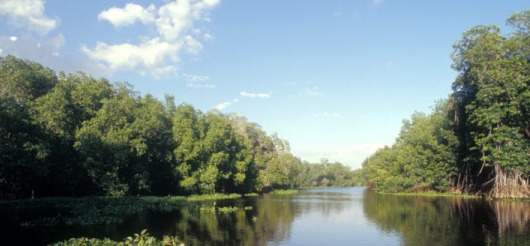Restoring The Natural Mangrove Forest
13 December 2019
13 December 2019
Coastal communities are intrinsically connected to the sea. Their lives depend on it. A key to happiness and life in tropical regions is a healthy mangrove forest.
We are now recognizing that a world without the rainforests by the sea, wouldn’t just mean a dismal scenario for coastal communities, but would...
Mangroves for the Future: A look back
13 December 2019
13 December 2019
Following the devastation of the Indian Ocean Tsunami in 2004, IUCN and UNDP recognised the vital link between healthy coastal ecosystems -- especially mangroves and coral reefs -- and the resilience of coastal communities to natural disaster. Their joint initiative, Mangroves for the Future (MFF), is now at the end...
The project "Integrated management of mangroves and associated wetlands and coastal forest ecosystems in the Republic of the Congo" was implemented between July 2013 and December 2017 by the Government of the Republic of the Congo and FAO. The main phase of the final evaluation, which took place between July...
The Mangrove Dynamics and Management Project (MADAM)
01 November 2016
01 November 2016
The MADAM Project in northern Brazil is designed to support research on the dynamics of mangrove ecosystems and on the formulation of management recommendations based on this knowledge. MADAM involves various scientific disciplines including ecology, biogeochemistry, meteorology, geography, socio-economics, and modeling.
Integrated Coastal Management Programme
01 November 2016
01 November 2016
The Integrated Coastal Management Programme in Vietnam addresses the various interlinked challenges facing the Mekong Delta by supporting the governmental authorities in their efforts to strengthen the coastal area and to cope with the environmental changes occurring there, while opening the way to sustainable growth. Using the ecosystem to protect...
Mangroves and Markets (MAM)
01 November 2016
01 November 2016
The development of shrimp aquaculture in Vietnam at the expense of the mangrove environment has serious consequences, as mangroves protect against tidal waves and storm surges; they are vital fish nursery-grounds; provide timber, honey, and other products; and raise land levels by trapping sediment. They also have high carbon content...
Mangrove Action Project (MAP)
01 November 2016
01 November 2016
Mangroves are vital for healthy coastal ecosystems in many regions of the world and research and studies are revealing the unique importance of these habitats to the planet. The Mangrove Action Project is dedicated to reversing the degradation and loss of mangrove forest wetlands and their associated coastal ecosystems worldwide....
Sri Lanka mangrove conservation project
01 November 2016
01 November 2016
Seacology, in collaboration with Sri Lanka-based NGO Sudeesa, works to make Sri Lanka the world’s first nation to comprehensively protect all of its mangrove forests. Their approach is to use job-training and microfinance programs to 15,000 impoverished Sri Lankans alternative ways to earn a living that do not entail cutting...
The Sustainable Wetlands Adaptation and Mitigation Program (SWAMP) is a collaborative effort by the Center for International Forestry Research (CIFOR), the USDA Forest Service (USFS) and Oregon State University with support from the US Agency for International Development (USAID).
The overall goal of the program is to provide policymakers with...
Mangroves increase fish habitat and protect shorelines
30 January 2015
30 January 2015
A few years ago, Carood Watershed Model Forest (Philippines) partners established a mangrove plantation near the mouth of the Carood River. The mangroves buffer strong waves and provide spawning habitat for coral fish, which are important for the livelihood of local fishermen. The plantation consists of 40 mangrove species to...

